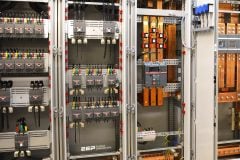RCD Classifications
For domestic applications only the first five of the below listed residual current devices (RCD) need to be considered. For industrial and commercial buildings all of the classifications need to be considered.

Table below aims to identify where each type of RCD can be used, together with the benefits provided. However, before looking at Table 2 there are two other classifications of RCD that need to be considered – general and time-delayed operation each having Type a.c., A or B characteristics.
RCCB
(Residual Current Operated Circuit Breaker without Integral Overcurrent Protection)
A mechanical switching device designed to make, carry and break currents under normal service conditions and to cause the opening of the contacts when the residual current attains a given value under specified conditions.
It is not designed to give protection against overloads and/or short-circuits and must always be used in conjunction with an overcurrent protective device such as a fuse or circuit breaker.
RCBO
(Residual Current Operated Circuit Breaker with Integral Overcurrent Protection)
A mechanical switching device designed to make, carry and break currents under normal service conditions and to cause the opening of the contacts when the residual current attains a given value under specified conditions.
In addition it is designed to give protection against overloads and/or short-circuits and can be used independently of any other overcurrent protective device within its rated short-circuit capacity.
SRCD
(Socket-Outlet incorporating a Residual Current Device)
A socket-outlet for fixed installations incorporating an integral sensing circuit that will automatically cause the switching contacts in the main circuit to open at a predetermined value of residual current.
FCURCD
(Fused Connection Unit incorporating a Residual Current Device)
A fused connection unit for fixed installations incorporating an integral sensing circuit that will automatically cause the switching contacts in the main circuit to open at a predetermined value of residual current
PRCD
(Portable Residual Current Device)
A device comprising a plug, a residual current device and one or more socket-outlets (or a provision for connection). It may incorporate overcurrent protection.
CBR
(Circuit Breaker incorporating Residual Current Protection)
A circuit breaker providing overcurrent protection and incorporating residual current protection either integrally (an Integral CBR) or by combination with a residual current unit which may be factory or field fitted.
The RCBO and CBR are more strictly defined by the relevant standards.
RCM
(Residual Current Monitor)
A device designed to monitor electrical installations or circuits for the presence of unbalanced earth fault currents. It does not incorporate any tripping device or overcurrent protection.
MRCD
(Modular Residual Current Device)
An independently mounted device incorporating residual current protection, without overcurrent protection, and capable of giving a signal to trip an associated switching device
Suitability of different types of RCD for different applications

Application Notes:
(1) Only if used in conjunction with suitable overcurrent protection (e.g. Fuse/circuit breaker)
(2) 10 mA RCDs are associated with highly sensitive equipment and high risk areas such as school laboratories and in hospital areas
(3) Yes provided 30mA or less, but not normally used
(4) With time delay
(5) CU – Consumer unit to BS EN 60439-3
(6) Must provide double pole isolation
(7) DB – Distribution Board; PB – Panel Board; SB – Switch Board
Resource: eama – The RCD Handbook | BEAMA Guide to the Selection and Application of Residual Current Devices











Thankyou Edvard, Can you comment on testing please?
We use a type 2 device 30 mA RCDs in an Industrial plant – rated at 30mA – tests are done to determine Tripping current at not more than 30 mA and tripping times where the disconnect time shall be not more than 300ms at In.
I would advocate a test to determine the <300ms at In.
Recently a mines inspector wanted to see RCDs tested 3 times; <300ms at In; <150ms at 2In and <40ms at 5In.
Is this necessary to prove at greater currents ?
Appreciate your input.
Very valuable
Thanks for usefull information